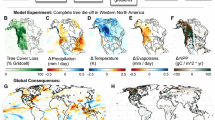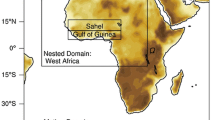Abstract
A coupled global vegetation–climate model is used to investigatethe effects of vegetation feedbacks on climate change due to doubling atmospheric CO2. The Equilibrium Vegetation Ecology model (EVE)simulates global terrestrial vegetation and is designed for interactive coupling with climate models. Terrestrial vegetation is resolved into110 plant life forms, which represent groups of species with similar physiognomic characteristics and migrational responses to climate change,thus preserving the spatial integrity of each life-form distribution as climate changes. EVE generates a quantitative description of plant community structure definedby total vegetation cover and the fractional covers of life formsas a function of climate. The equilibrium distribution of each life form is predicted from monthly mean temperature, precipitation, and relative humidity,based on observed correlations with the present climate.The fractional covers of the life forms at each site are determined by parameterizations of dynamic ecological processes: competition for sunlight, disturbances by fire and treefall. A second model (LEAF) simulates the seasonal phenology of EVE's plant canopies, driven by the daily climate at each location, and provides the physical quantities needed for coupling vegetation and climate models.Two pairs of coupled EVE-GCM simulations are described, both with 1× and 2×CO2:the first with prescribed fixed vegetation, and the other with fully interactive vegetation. Large effects of vegetation feedbacks in the interactive simulations are found at the northern and southern ecotones of the boreal forest. Poleward migration of boreal forests into tundra caused by warming due to elevated CO2 is enhanced by a strong snow-masking albedo feedback, consistent with earlier studies. The invasion of temperate grasslands into the southern boreal forest is also enhanced due to summer warming spreading from the north, despitethe opposing sense of the grassland-forest albedo feedback. Desertification of subtropical grasslands is mostly reversed in the interactive simulations due to enhanced monsoonal precipitation. These interactions and other climate and plant community changes caused by climate-vegetation feedbacks are discussed on a regional basis.
Similar content being viewed by others
References
Beerling, D. J., Woodward, F. I., Lomas, M., and Jenkins, A. J.: 1997, ‘Testing the Responses of a Dynamic Global Vegetation Model to Environmental Change: A Comparison of Observations and Predictions’, Global Ecol. Biogeog. Lett. 6,439–450.
Betts, R. A., Cox, P. M., Lee, S. E., and Woodward, F. I.: 1997, ‘Contrasting Physiological and Structural Vegetation Feedbacks in Climate Change Simulations’,Nature 387,796–799.
Bonan, G. B., Pollard, D., and Thompson, S. L.: 1992, ‘Effects of Boreal Forest Vegetation on Global Climate’, Nature 359,716–718.
Botkin, D. B., Janak, J. F., and Wallace, J. R.: 1972a, ‘Some Ecological Consequences of a Computer Model of Forest Growth’, J. Ecol. 60, 849–872.
Botkin, D. B., Janak, J. F., and Wallace, J. R.: 1972b, ‘Rationale, Limitations and Assumptions of a Northeast Forest Growth Simulator’,IBM J. Res. Develop. 16,101–116.
Box, E. O.: 1981a,Macroclimate and Plant Forms: An Introduction to Predictive Modeling in Phytogeography, Dr. W. Junk Publishers, The Hague, p. 258.
Box, E. O.: 1981b, ‘Predicting Physiognomic Vegetation Types with Climate Variables’, Vegetatio 45,127–139.
Charney, J., Stone, P. H., and Quirk, W. J.: 1975, ‘Drought in the Sahara: A Biogeophysical Mechanism’,Science 187,434–435.
Claussen, M. and Gayler, V.: 1997, ‘The Greening of the Sahara during the Mid-Holocene: Results of an Interactive Atmosphere-Biome Model’,Global Ecol. Biogeog. Lett. 6, 369–377.
Claussen, M., Brovkin, V., Ganopolski, A., Kubatzki, C., and Petoukhov, V.: 1998, ‘Modelling Global Terrestrial Vegetation–Climate Interactions’, Phil. Trans. Roy. Soc. London B 353,53–63.
Costa, M. H. and Foley, J. A.: 1999, ‘Combined Effects of Deforestation and Doubled Atmospheric CO2 Concentrations on the Climate of Amazonia’, J. Climate 13,18–34.
Culotta, E.: 1995, ‘Will Plants Profit from High CO2?’,Science 268,654–656.
Davis, M. B.: 1983, ‘Quaternary History of Deciduous Forests of Eastern North America and Europe’, Ann. Missouri Bot. Gard. 70,550–563.
DeConto, R. M., Brady, E. C., Bergengren, J., and Hay, W. W.: 2000, ‘Late Cretaceous Climate, Vegetation and Ocean Interactions’, in Huber, B. T., MacLeod, K. G., and Wing, S. L. (eds.), Warm Climates in Earth History,Cambridge University Press, pp. 275–296.
de Noblet, N. I., Prentice, I. C., Joussaume, S., Texier, D., Botta, A., and Haxeltine, A.: 1996, ‘Possible Role of Atmosphere-Biosphere Interactions in Triggering the Last Glaciation’, Geophys. Res. Lett. 23, 3191–3194.
Doherty, R., Kutzbach, J., Foley, J., and Pollard, D.: 2000, ‘Fully-Coupled Climate/Dynamical Vegetation Model Simulations over Northern Africa during the Mid-Holocene’,Clim. Dyn. 16, 561–573.
Foley, J. A., Levis, S., Costa, M. H., Cramer, W., and Pollard, D.: 2000, ‘Incorporating Dynamic Vegetation Cover within Global Climate Models’, Ecol. Appl. 10,1620–1632.
Foley, J. A., Levis, S., Prentice, I. C., Pollard, D., and Thompson, S. L.: 1998, ‘Coupling Dynamic Models of Climate and Vegetation’,Global Change Biol. 4,561–579.
Foley, J. A., Prentice, I. C., Ramankutty, N., Levis, S., Pollard, D., Sitch, S., and Haxeltine, A.: 1996, ‘An Integrated Biosphere Model of Land Surface Processes, Terrestrial Carbon Balance, and Vegetation Dynamics’,Global Biogeochem. Cycles 10,603–628.
Friend, A. D., Stevens, A. K., Knox, R. G., and Cannell, M. G. R.: 1997, ‘A Process-Based, Terrestrial Biosphere Model of Ecosystem Dynamics (Hybrid v3.0)’,Ecol. Model. 95, 249–287.
Ganopolski, A., Kubatzki, C., Claussen, M., Brovkin, V., and Petoukhov, V.: 1998, ‘The Influence of Vegetation-Atmosphere-Ocean Interaction on Climate during the Mid-Holocene’, Science 280, 1916–1919.
Haxeltine, A. and Prentice, I. C.: 1996, ‘BIOME3: An Equilibrium Terrestrial Biosphere Model Based on Ecophysiological Constraints, Resource Availability and Competition among Plant Functional Types’, Global Biogeochem. Cycles 10,693–709.
Henderson-Sellers, A.: 1993, ‘Continental Vegetation as a Dynamic Component of a Global Climate Model: A Preliminary Assessment’, Clim. Change 23, 337–378.
Hewitt, C. D. and Mitchell, J. F. B.: 1998, ‘A Fully Coupled GCM Simulation of the Climate of the Mid-Holocene’, Geophys. Res. Lett. 25, 361–364.
Holdridge, L. R.: 1947, ‘Determination of World Plant Formations from Simple Climatic Data’, Science 105,267–268.
Jolly, D. and Haxeltine, A.: 1997, ‘Effect of Low Glacial Atmospheric CO2 on Tropical African Montane Vegetation’, Science 276,786–788.
Koppen, W.: 1931,Grunde der Klimakunde,Walter de Gruyter, Berlin, Germany.
Koppen, W.: 1936, ‘Das geographisches System der Klimate’, in Koppen, W. and Geiger, R. (eds.),Handbuch der Klimatologie, Volume I,Gegruder Borntraeger, Berlin.
Kuchler, A. W.: 1990, ‘World Map of Natural Vegetation’, in Goode' World Atlas, 16th edn., Rand McNally, pp. 16–17.
Kutzbach, J. E. and Liu, Z.: 1997, ‘Response of the African Monsoon to Orbital Forcing and Ocean Feedbacks in the Middle Holocene’, Science 278,440–443.
Kutzbach, J. E., Bonan, G., Foley, J. A., and Harrison, S. P.: 1996, ‘Vegetation and Soil Feedbacks on the Response of the African Monsoon to Orbital Forcing in the Early to Middle Holocene’, Nature 384,623–626.
Lean, J. and Rowntree, P. R.: 1997, ‘Understanding the Sensitivity of a GCM Simulation of Amazonian Deforestation to the Specified Vegetation and Soil Characteristics’, J. Climate 10, 1216–1235.
Leemans, R. and Cramer, W. P.: 1990, The IIASA Database for Mean Monthly Values of Temperature, Precipitation and Cloudiness of a Global Terrestrial Grid,WP-41, International Institute of Applied Systems Analyses, Laxenburg Working Paper, IIASA, Laxenburg, Austria, p. 60.
Legates, D. R. and Willmott, C. J.: 1990a, ‘Mean Seasonal and Spatial Variability in Global Surface Air Temperature’, Theor. Appl. Climatol. 41, 11–21.
Legates, D. R. and Willmott, C. J.: 1990b, ‘Mean Seasonal and Spatial Variability in Gauge-Corrected Global Precipitation’,Int. J. Clim.10,111–127.
Levis, S., Foley, J. A., and Pollard, D.: 1999a, ‘Potential High-Latitude Vegetation Feedbacks on CO2-Induced Climate Change’, Geophys. Res. Lett. 26,747–750.
Levis, S., Foley, J. A., and Pollard, D.: 1999b, ‘CO2, Climate, and Vegetation Feedbacks at the Last Glacial Maximum’, J. Geophys. Res. 104,31191–31198.
Levis, S., Foley, J. A., Brovkin, V., and Pollard, D.: 1999c, ‘On the Stability of the High-Latitude Climate-Vegetation System in a Coupled Atmosphere-Biosphere Model’, Global Ecol. Biogeog. 8,489–500.
Levis, S., Foley, J. A., and Pollard, D.: 2000, ‘Large-Scale Vegetation Feedbacks on a Doubled CO2 Climate’,J. Climate 13,1313–1325.
Lieth, H. F. H.: 1975, ‘Modelling the Primary Productivity of the World’, in Lieth, H. and Whittaker, R. H. (eds.), Primary Productivity of the Biosphere. Ecological Studies 14,Springer-Verlag, pp. 275–296.
Matthews, E.: 1983, ‘Global Vegetation and Land Use: New High Resolution Data Bases for Climate Studies’,J. Clim. Appl. Meteorol. 22,474–487.
Monserud, R. A. and Leemans, R.: 1992, ‘Comparing Global Vegetation Maps with the Kappa Statistic’,Ecol. Model. 62, 275–293.
Neilson, R. P.: 1995, ‘A Model for Predicting Continental-Scale Vegetation Distribution and Water Balance’,Ecol. Appl. 5,362–385.
Pollard, D. and Thompson, S. L.: 1995, ‘Use of a Land-Surface-Transfer Scheme (LSX) in a Global Climate Model: The Response to Doubled Stomatal Resistance’,Global Planet. Change 10, 129–161.
Pollard, D., Bergengren, J. C., Stillwell-Soller, L. M., Felzer, B., and Thompson, S. L.: 1998, ‘Climate Simulations for 10000 and 6000 Years BP Using the GENESIS Global Climate Model’, Palaeoclimates – Data Modelling 2, 183–218.
Prentice, I. C., Cramer, W., Harrison, S. P., Leemans, R., Monserud, R. A., and Solomon, A. M.: 1992, ‘A Global Biome Model Based on Plant Physiology and Dominance, Soil Properties and Climate’,J. Biogeogr. 19, 117–134.
Robinson, D. A. and Kukla, G.: 1985, ‘Maximum Surface Albedo of Seasonally Snow-Covered Lands in the Northern Hemisphere’,J. Clim. Appl. Meteorol. 24,402–411.
Schutz, C. and Gates, W. L.: 1971,Global Climatic Data for Surface, 800 mb, 400 mb: January,The Rand Corporation, R-915-ARPA.
Schutz, C. and Gates, W. L.: 1972,Global Climatic Data for Surface, 800 mb, 400 mb: July, The Rand Corporation, R-1029-ARPA.
Schutz, C. and Gates, W. L.: 1973,Global Climatic Data for Surface, 800 mb, 400 mb: April, The Rand Corporation, R-1317-ARPA.
Schutz, C. and Gates, W. L.: 1974,Global Climatic Data for Surface, 800 mb, 400 mb: October, The Rand Corporation, R-1425-ARPA.
Texier, D., de Noblet, N., Harrison, S. P., Haxeltine, A., Jolly, D., Joussaume, S., Laarif, F., Prentice, I. C., and Tarasov, P.:1997, ‘Quantifying the Role of Biosphere-Atmosphere Feedbacks in Climate Change: Coupled Model Simulations for 6000 Years BP and Comparison with Paleodata for Northern Eurasia and Africa’,Clim. Dyn. 13,865–882.
Thompson, S. L. and Pollard, D.: 1995a, ‘A Global Climate Model (GENESIS) with a Land-Surface Transfer Scheme (LSX). Part I: Present Climate Simulation’,J. Climate 8,732–761.
Thompson, S. L. and Pollard, D.: 1995b, ‘A Global Climate Model (GENESIS) with a Land-Surface Transfer Scheme (LSX). Part II: CO2 Sensitivity’,J. Climate 8,1104–1121.
Thornthwaite, C. W. and Mather, J. R.: 1957, ‘Instructions and Tables for Computing Potential Evapotranspiration and the Water Balance’, Climatology 10, 185–311.
VEMAP Members: 1995, ‘VEMAP: A Comparison of Biogeography and Biogeochemistry Models in the Context of Global Climate Change’,Global Biogeochem. Cycles 9,407–437.
Webb, T. III: 1987, ‘The Appearance and Disappearance of Major Vegetational Assemblages: Long-Term Vegetational Dynamics in Eastern North America’, Vegetatio 69,177–187.
Willmott, C. J. and Klink, K.: 1986, ‘A Representation of the Terrestrial Biosphere for Use in Global Climate Studies’, in Proceedings of the ISLSCP Conference, Rome, Italy, December 1985, European Space Agency, Paris, pp.109–112.
Woodward, F. I., Smith, T. M., and Emanuel, W. R.: 1995, ‘A Global Land Primary Productivity and Phytogeography Model’, Global Biogeochem. Cycles 9,471–490.
Author information
Authors and Affiliations
Rights and permissions
About this article
Cite this article
Bergengren, J.C., Thompson, S.L., Pollard, D. et al. Modeling Global Climate–Vegetation Interactions in a Doubled CO2 World. Climatic Change 50, 31–75 (2001). https://doi.org/10.1023/A:1010609620103
Issue Date:
DOI: https://doi.org/10.1023/A:1010609620103




